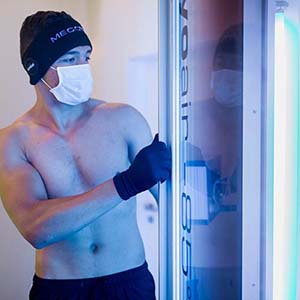Cryotherapy
for Arthritis
Cryotherapy for Arthritis
Inflammation and pain in a joint are symptoms of arthritis, a common illness.
Over 10 million people in the UK suffer from arthritis or other disorders that are comparable and damage the joints.
All ages, including children, are impacted by arthritis.
Improving Symptoms with Cryotherapy for
Arthritis Treatment
Muscle and joint discomfort can be effectively treated with cryotherapy. Because of this, it serves as the ideal treatment for arthritis sufferers. It delivers total body relief as opposed to concentrating on one joint at a time.
Your body is shocked into thinking it is frozen during cryotherapy. A semi-hypothermic response is induced by this. Your breathing will slow down, your heart rate will decrease, and your body will focus its energy on maintaining a healthy core temperature.
Additionally, it accelerates the blood flow rate. These combined impacts hasten your body’s natural healing processes.
Toxins that have been accumulated in the joints are released into the bloodstream during this process. When they are finished, your kidneys and liver can remove them from your body and reduce inflammation.
Joint discomfort is not the only issue that many people with arthritis worry about. Pain and suffering can also be brought on by associated illnesses such inflammation, neuralgia, and autoimmune problems. Here are some of the less-publicized effects of arthritis that cryotherapy may be able to alleviate.
What is Arthritis?
Osteoarthritis and rheumatoid arthritis are the 2 most common types of arthritis.
Osteoarthritis
The most prevalent kind of arthritis in the UK, affecting approximately 9 million individuals, is osteoarthritis.
Most frequently, it strikes those in their mid-40s or older.
In addition, women and those with a family history of the illness are more likely to experience it.
However, it can happen at any age as a result of an accident or be linked to other joint-related diseases like gout or rheumatoid arthritis.
The smooth cartilage that lines the joint is initially impacted by osteoarthritis. Movement becomes more challenging than usual as a result, resulting in discomfort and stiffness.
The tendons and ligaments must work harder when the cartilage lining begins to deteriorate and become rougher.
Osteophytes, which are bone spurs, may occur as well as swelling.
Chronic cartilage loss can cause the bones to rub against one another, changing the form of the joint and displacing the bones from their natural positions.
The joints that are most frequently impacted are those in the:
- Hands
- Spine
- Knees
- Hips
Rheumatoid arthritis
Rheumatoid arthritis affects around 400,000 persons in the UK.
When a person is between 40 and 50 years old, it frequently begins. Women are three times as likely than men to be impacted.
The immune system of the body attacks the afflicted joints in rheumatoid arthritis, causing discomfort and swelling.
The first area to be impacted is the joint’s synovium, or outer coating.
This may then spread throughout the joint, causing more swelling and a change in the form of the joint. The bone and cartilage could deteriorate as a result of this.
Rheumatoid arthritis patients may also experience complications with various body organs and tissues.
Cryotherapy reduces Inflammation
Many patients with arthritis struggle with swelling in and around the joints. If left untreated, this swelling may limit the range of motion and make tasks more difficult.
By stimulating your lymphatic system, cryotherapy reduces this inflammation. Your lymphatic ducts constrict in the cold, moving lymph through your body and eliminating toxins and cellular debris.
Additionally, as your blood arteries widen, more white blood cells might enter the area. They’ll eliminate any harmful compounds in the lymph and reduce the inflammatory reaction in your body.
Cryotherapy Alleviates Autoimmune Diseases
Rheumatoid arthritis is an autoimmune condition, while osteoarthritis results from the deterioration of connective tissue and bone. The body’s cells target joints and connective tissue in this situation as if they were infections.
Cryotherapy, according to research, causes your joints’ internal temperatures to drop. Numerous elements that cause joint inflammation and damage are suppressed by this.
These same elements, such as cytokines and toxic enzymes, cause injury in many autoimmune diseases. Cryotherapy can therefore be helpful for other chronic pain-causing disorders like fibromyalgia and multiple sclerosis.
Cryotherapy For Nerve Pain
Peripheral neuropathy is a daily problem for many arthritis sufferers. Due to injured and inflamed nerve endings, this illness causes numbness, tingling, and pain in the extremities.
Using ice on these already sensitive areas can make the pain and discomfort even worse. Cryotherapy for rheumatoid arthritis can help alleviate some of this discomfort without the pain of icing.
How frequently should I use a Cryotherapy Chamber for Arthritis treatment?
It’s time to take action if you’re sick of living with the pain, weakness, and loss of function that come with arthritis. An efficient, low-risk investment, cryotherapy for arthritis can help you resume living life to the fullest.
Are you ready to try this cutting-edge treatment? Starting Cryotherapy at Pure Medical is highly recommended. Our skilled staff uses cryotherapy together with other modalities like infrared sauna and HBOT treatment to provide a holistic approach to wellbeing.
Call us or send an online message to us right away. We would be pleased to help you schedule your first consultation and respond to any enquiries you may have.
Our treatment programmes are tailored to the patient, It’s crucial to pay attention to your body and stop using the cryotherapy chamber if you feel any negative side effects.
If you or someone you love is suffering from Arthritis please contact Pure Medical for a Cryotherapy treatment consultation.


